There is an article has floated around for a couple years now that takes photos of specific breeds from 100 years ago and compares them with photos from current representatives of the breed. It contends that dogs from 100 years ago were “better” than today’s dogs and that today’s breeds are “suffering.” The article is so full of misinformation that I had hoped it had just faded away. However, recently it was reposted by someone who makes a living training dogs for performance events, so I finally felt compelled to address the misinformation in the article.
DOG SHOWS 101
I’m sure you watched Westminster Kennel Club dog show or the Eukanuba Championship Dog Show on Television. You’ve watched, bemused, as people parade their dogs up and down in front of the judge. But what is actually going on there?
Dog shows are so much more than “just a beauty contest.”
The purpose of a dog show is to evaluate breeding stock and the way the stock is evaluated is to look at their physiology and their physical soundness to find if they would be able to do the jobs for which they were bred.
This can be as simple as “Does the Labrador have webbed feet and thick tail that it needs to best do its job of swimming to retrieve ducks” to something as interesting as “does this sight hound have the proper elasticity of spine so that it will be capable of doing the double suspended gallop it must do in order to run down its prey.” But ultimate it is the judges having a solid background and understanding of how dogs should be put together and what is the best way for that conformation to help the dog best do what it is supposed to do. This is why dogs are judged moving. Much is learned about how the dog is put together by the way it moves.
Finally the cosmetic portion of the judging isn’t just “beauty.” It’s “does this dog LOOK like the breed it is?” Is it a good representation of a Cocker Spaniel or a Rottweiler? A “breed” isn’t something that happens when you put two dogs together. The “poo” and “doodle” breeds are, in fact, not breeds. Breeds must “breed true” which means when you breed two of them together, the pups will look like the parents. You would never breed together two Rottweilers and have them produce something that looks like a chihuahua. That is because they are both breeds that produce offspring that are consistent in look. This is why “poos” and “doodles” are not breeds. They do not consistently produce offspring that conform to any regular set of criteria.
Because the article is so full of errors and opinions given as fact, that I will not post a link to it. I will simply address their points, breed by breed. I have copied the photos they used for comparison and I will go over the photos with a judge’s eye. That way we can see if the dogs pictured in the older pictures are actually “better” than the contemporary dogs.
Let’s begin.
The Bull Terrier
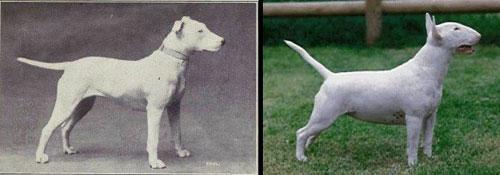
1. Antique Bull Terrier
Front: This dog has straight shoulders and a short upper arm. This impedes movement of the leg as it is carried forward in motion. This means the dog will not “reach” forward and “pull” the ground toward it as it moves.
Rear: This dog is straight in the rear and has very little bend of stifle. This will impede the motion of the rear legs as it tries to “drive” or “push” forward in movement. This combined with the straight shoulders and short upper arm means the dog will expend a lot of energy and not move forward very well.
Topline: The topline slopes from rear to front. This is indicative of the fact the angles of the shoulders and the angles of the rear do not match. In this case, the straight rear does not allow the croup to “sit down” enough to level the topline; again indicative of a rear that will not supply enough “drive” to propel the dog forward efficiently.
Headtype: this dog is very lacking in what we refer to as ‘breed type.” In fact, today it would likely be labeled a “pit bull” or a Pit-mix.
2. Contemporary Bull Terrier
Front: This dog has nicely laid back shoulders, feet point forward and strong pasterns. It has adequate upper arm length so that it will reach forward when it moves, pulling the ground toward it.
Rear: There is a good bend of stifle and good angles in the rear. This will provide for solid “drive” or “push” forward when the dog moves
Topline: A hard solid level topline indicates the dog is balanced, front and rear. This dog will move efficiently and with good power.
Headtype: this dog looks like a bull terrier. No, it’s not the look for everyone, but that is fine. It is not unhealthy nor does it impede the dog in any way. The dog is not “suffering” as this article states.
The writer goes on to make vague accusation of “long list of ailments” and “compulsive tail chasing” but fails to give any references or resources from which they got this information. Unsubstantiated information like this only serves to hurt the breed and those that love them.
Basset Hound
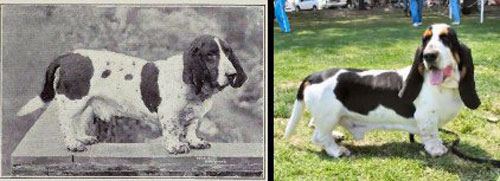
3. Antique image: Basset Hound
Front conformation: This dog has shoulders that are straight which makes it appear as if he has an extremely short neck. It also has very short upper arms. This means the front legs would have very little way to move forward as the dog traveled. There would be little to no “reach” forward as the dog moved, meaning its front movement would be extremely ineffective.
Rear: Very little bend of stifle coupled with very long hocks means this dog would have very little ability to “drive” or “push” forward as it moved. It would have to take many strides to cover as much ground as its contemporary counterpart did in fewer strides.
Topline. The dog’s topline is swayed – higher in the rear than in the front. This speaks to the poor rear angulation which makes the rear not sit down where it should to provide proper drive.
Remember, this breed was bred to accompany a hunter who was on foot (as compared to hunting from horseback.) This particular example of the breed would take very short strides, meaning it would have to take many steps to keep up with his hunter. It would tire out pretty quickly. Likewise the set up shoulders give it less room to move its neck, meaning it has to move more of its body to actually turn its head. This makes for a dog that cannot turn or move swiftly without having to move its entire body – another reason it would tire out quite quickly when out with its hunter.
4. The Contemporary Basset photo
Front conformation: this dog’s shoulders are laid back at the proper 45 degree angle. This ensures he has enough neck to provide movement and enough room to provide good reach in the front. His elbows are nicely tucked in. His pasterns are straight. This will likely give him enough room for clean forward movement of the foot and leg as he’s traveling
Rear Conformation – nicely angled rear and straight hocks means he will have drive in the rear to push him forward as his reaching front pulls. It’s what is needed to provide clean, efficient movement
Topline – a nice straight topline giving the neck enough room to move with agility. Overall, this dog will likely be able to move with his hunter throughout the day.
The writer makes mention of “eye problems” and “vertebrae problems” but gives no resources or references or even specifics of what that means. They also refer to the ears as “needlessly long” which is, of course, highly subjective and simply a matter of their personal taste.
The Boxer

5. The Antique Boxer
Front end – while not as extreme as the antique basset hound, there is still a straightness of shoulder indicated by the point of the shoulder being just slightly forward of the withers. Again we have the impression of a shorter neck caused by the straightness of the shoulders and the straight shoulders give him less room to hold his up, resulting in the forward carriage of the head.
Back end – The rear is moderately angled with a moderate bend of stifle, however the hocks are long in comparison to the rest of the leg. This means the rear legs have more room to travel than the front legs do. Usually when a dog has more angles in the rear than the front, the dog will have to overreach or “crab” to compensate.
Topline: In this case, the topline rises over the croup and slopes toward the withers. This is a result of the imbalance in the front and rear angles and is another indication that this animal will likely overreach and/or “crab” when he moves. Either way it is an inefficient movement. His tailset is low, emphasizing the sloping croup.
Head and neck ; This dog is thick through the throatlatch area and his ears are cropped, something that is usually heavily frowned on by the animal rights world. And, if you showed someone this photo today with no context, they would assume they were looking at a pitbull or some mix breed. It doesn’t look like a boxer.
6. Contemporary Boxer Photo
Front: shoulders nicely laid back for proper freedom of movement. Feet round, pasterns firm and straight. Good length of neck showing for proper flexibility and agility
Rear: good angulation, good bend of stifle. Feet round and tight. All the signs this animal will have reach and drive without sidewinding or crabbing.
Topline – level topline indicating balance of front and rear
Head and neck – neck shows good length, tight throatlatch. The head is typical of the Boxer breed.
The writer states “Brachys have difficulty breathing and controlling their body temperature, which often places extreme limitations on their physical abilities.” There are no resources or references to back up this claim. Also, a quick search of youtube shows Boxers competing in many different performance sports and doing so just as well as their non brachycephalic breeds. Also, BOTH dogs are brachycephalic. It is well known that brachycephalic dogs have less ability to cool than non brachycephalic, however it is no worse today than it was 100 years ago.. unless you count climate change.
The Bulldog

7. Antique bulldog
Front: this dog is out at the elbow, meaning the elbow are protruding away from the body rather than tucked in against the body. His feet are toed-out. This would be close to what we would call a “fiddle front.” This flaw also indicates the dog may be predisposed to arthritis(1) .
Back: it is difficult to judge the back or topline of this dog as the shot is ¾ view, however you can see the placement of his rear feet, showing that they, too, are toed out like his front
Topline and head: We cannot see the topline on this dog, although we can see that his rear appears to be higher than his shoulders, however we will disregard that due to the angle of the photo. This dog is brachycephalic and has an upturned nose. It is quite clear this is a Bulldog.
8. Contemporary Bulldog
Front, this is a heavily muscled dog and is quite “wet” (meaning lots of loose skin.) His elbows are nicely tucked in. We cannot see his feet, but the legs going down are straight.
Rear: Due to the angle of the photo it is difficult to look at the rear.
Topline: Once again, due to the angle we cannot tell the topline
Head: As stated above, this dog is quite heavy with loose skin. While that is not uncommon on bulldogs he is at the more extreme end. He shows the proper short muzzle and upturned nose. He is not “alert” at the time of the photo so his ears are not “perked” like the antique dog, but they appear to be in the proper alignment.
First, a small point but important as it indicates how well the writer has educated themselves on purebred dogs, there is no breed called “English Bulldog” registered by the AKC. The AKC only acknowledges the “Bulldog.”
The Bulldog was designed to have a short muzzle with an upturned nose. Both of the photos show that. This conformation was to give the dog the ability to grab onto a bull’s nose and grip it tightly and still be able to breath. The breed was always intended to be heavily boned so that its weight on the bull’s nose would wear the bull down faster. Not a pretty thought, but that’s what they were bred for.
While its occupation no longer exists, I do not see any reason why the current dog couldn’t do the job every bit as well as the antique picture.
While bracechephalics do have heat considerations, the article states that the bulldog has an “endless list of health problems” yet does not list them nor supply a reference to were this idea comes from.
They go on to state that “(Bulldogs) can’t reproduce without medical intervention.” This is flatly untrue. They can reproduce naturally; it’s just much easier and healthier for the bitch if they do not. And frankly, turkeys today don’t mate naturally and neither do most beef or dairy cattle.
The Smooth Dachshund
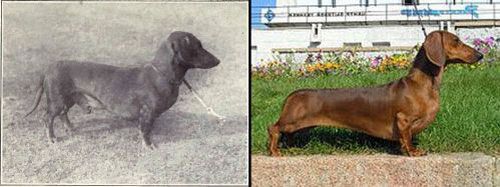
9. Antique Smooth Dachshund
Front: it’s becoming a bit of a pattern with these older dog photos, but the shoulder conformation is not good. We see here again that the dog has straight shoulders, giving the animal the appearance of a short neck. That combined with the short upper arms would likely give this animal either a ‘windmill’ front or simply no reach when they move.
Back: Again, straight in the rear conformation, however more angulation than the front. this animal would either over reach or sidewind in its movement.
Topline: Once again the topline slops from the hips down to the front shoulders. This is a result of the front and the back angles being out of balance.
10. Contemporary smooth Dachshund
Front: Shoulders well laid back giving the animal the appearance of a longer neck. Once again providing for agility of movement in the neck and back. The shoulder alignment means this animal will have the reach necessary to cover ground well and efficiently. Feet are turned neither out nor in, showing good straight pasterns.
Rear: correct angulation in the rear with good bend of stifle means the animal can drive efficiently.
Topline: solid, strong and level.
While the dachshund does have a high incident of back problems, that is to be expected with the long back. However, they go on to make claims of the dachshund having more PRA (progressive retinal atrophy – an inherited eye disorder) and something undefined they calls “leg problems.” In all cases there are no references or referrals to where this information came from. There is also a reference made to a “long neck.” There is no way a dog can actually have a “longer” neck. The number of vertebrae in the neck is always the same number. What can be done is the dog can have proper shoulder placement that makes the neck appear longer. This proper shoulder placement give the dog more flexibility in its neck area, allowing it to turn its head without moving the entire body.
The German Shepherd
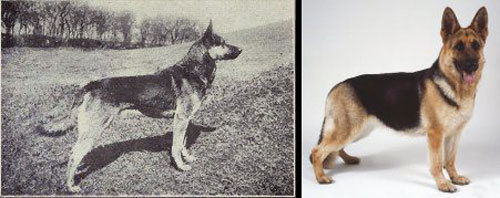
11. Antique German Shepherd
Front: the front conformation on this dog isn’t bad. He appears to have nice shoulders, laid back so as to give the neck room to move and front legs the freedom to reach.
Rear: Here is where this dog gets into problems. This dog is very straight in the rear with very little bend of stifle. He is so straight up and down in the rear that he is higher in the croup than he is at the withers. How do we know? Because the photographer knew this and placed him on a hill with his front feet above his rear in order to level out his topline. This dog will likely be a very poor mover with his back feet having no where near the drive to keep up with the front.
Topline: we already covered this in the above statement. This dog is high in the rear due to his very straight angles in the back.
Head: this dog appears to have a nice head piece for the time. It is still recognizable as a German Shepherd.
12. Contemporary German Shepherd dog
Front: Nice shoulders, well laid back giving the dog the room it needs to freely reach with the front legs. Also to give the neck room to be agile. Feet are facing forward, neither toeing in nor out.
Rear: This dog has good angles in the rear and a bit more bend of stifle than I would like to see. However, the angulation of the hip conformation is in line with the front and this dog will likely cover ground quite well.
Topline: It is hard to tell from the angle of the picture but this dog’s topline is either level or slopes slightly from withers to croup. This is a solid topline that is representative of the balanced shoulders and hips.
Head: this dog exhibits a lovely typical German Shepherd head. Anyone, anywhere would recognize the breed.
This poor breed has taken more abuse from the animal rights/anti purebred dog people than any other short of the bulldog. And, once again, the statements include unsubstantiated information including an inference that the current German Shepherd is incapable of performance work such as clearing a wall. The author of this article apparently did not think to check youtube where one may find many videos of current German Shepherds doing agility work, schutzhund work and herding work and, yes, scaling walls. It is a shame that breeders who have done so much to eliminate hereditary problems from their breed are continually accused of “ruining” the breed.
The Pug
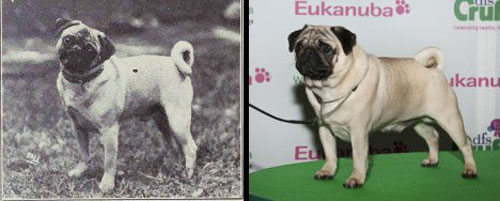
13. Antique Pug
Front: This dog has nice shoulders, however its front feet are long, its pasterns appear weak and its feet are toed out.
Rear: This dog is straight in the rear, resulting in a croup that is higher than its withers. This straightness causes the back legs to not be able to “drive” effectively thus the dog does not cover ground efficiently.
Topline: Because the rear is straight, it does not “set down” enough to lower the croup; resulting in croup that is higher than the withers and a topline that slopes forward.
Head; this dog shows a typical brachycephalic headtype for this breed. It is just as short faced as the current dog.
14. Contemporary Pug
Front: nicely laid back shoulders. Feet and pasterns straight and strong. Feet are forward facing – neither toeing in nor out.
Rear: rear angles are appropriate and balanced. The feet toe out just very slightly and I would fault him for that.
Topline: good strong, level, topline which is evidence of the balanced front and rear
Head: this dog shows a typical brachycephalic headtype which is no more extreme than the dog in the old photograph
The article’s writer makes vague statements about “breathing troubles” and other health concerns, yet gives no back up to support these statements at all.
The Saint Bernard
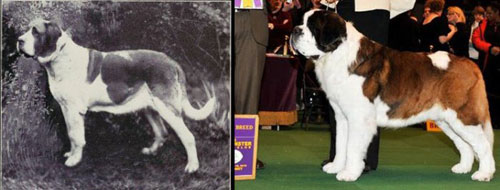
15. Antique St Bernard
The first thing that is important to note about these two pictures is they are showing two different coat types. The old picture is a short coated St Bernard and the new photo is a long coated St Bernard. This is going to make them look quite different to the inexperienced eye.
Front: this dog seems to be well laid back in the shoulders, however the feet are oval, not round and there does seem to be some weakness in the pasterns
Rear: This dog is very straight in the rear, has very little bend of stifle and appears to be cow hocked (meaning the hocks pull in toward each other when the dog is standing straight) It is not unusual for a dog that is very straight with little bend of stifle, but long hocks to have “cow hocks.” This dog would have little drive in the rear when moving and certainly would be out of balance with the front. This could result in crabbing, flinging the legs and other ineffective gait problems.
Top line: This dog is slightly higher in the rear than the front, probably due to the straightness in the rear conformation
Head type: not terribly typical of the breed but not too far off. It does look at bit more like a Mastiff than St Bernards do today, but it is still fairly recognizable as a St Bernard.
16. Current St Bernard
Again, it is important to note that this dog is a long coated St Bernard while the antique photo is of a short coated St Bernard. Much of what the writer identifies as “squished in” is actually fur that has been “fluffed forward” for show.
Front: Shoulders nicely angled. Feet tight and round. Pasterns strong
Rear: angled, but could carry a bit more. Feet round and nicely placed. Overall this dog should have reach and drive and be able to move efficiently enough that hunting all day for avalanche victims would be possible.
Topline: Level top line indicating balance of front and rear
Head: Typical St Bernard head type. Large enough to carry a brandy keg and reflective of what people today think of when they think of a St Bernard
Once again, the article’s writer makes unfounded statements about health and vague accusations about ‘overheating” yet provides no resources to back up any of the accusations.
In every single case we can see that dog breeders have actually IMPROVED their breeds over the last century. They have produced balanced dogs with good physical conformation that are well suited for doing the jobs for which they were bred. Perhaps there may be cosmetic changes that certain people may not care for, but in NO way do those changes cause suffering or harm as the writer states. This does not even touch on the amazing genetic work breeders have done – from ferreting out genetic problem to supporting the research needed to discover and find a cure for these things.
It is clear this article was written by someone with no knowledge of canine conformation or physiology and, furthermore, by someone unable to see beyond their own bias of what a dog should be. In each case they make accusations regarding health condition of modern purebreds with no basis in fact and no references or resources to back up their accusations. Finally they have no understanding of what purebred dogs are or what dog shows are about. I can only conclude that this is nothing more than a jab at purebred dogs by those who do not believe they should exist at all.
After 30+ years of showing dogs I have never run into any exhibitor that didn’t love their dogs, want their dogs to be healthy and would go without food themselves before doing anything that would harm their dogs. Not one I have ever met, knew or even heard of by name was “in it for money.” Yet people involved in the world of AKC show and performance events are continually slammed, mocked and accused of animal cruelty by people such as the author of this article. It has to stop or there will be no purebreds left. And while that is what the animal rights movement actually wants(2) , I will not stand for it… and neither should anyone who is involved in this hobby.
(and unlike the author of the article, I DO include references)
(1) http://journals.plos.org/plosone/article?id=10.1371/journal.pone.0075621
(2) “In the end, I think it would be lovely if we stopped this whole notion of pets altogether.” Ingrid Newkirk – founder and vice president of PETA, Newsday, 1988 February 21